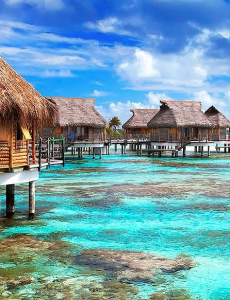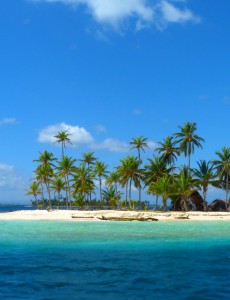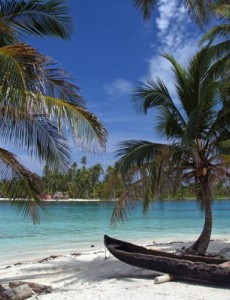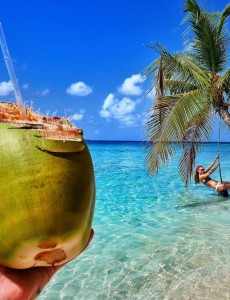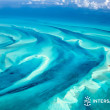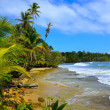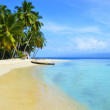
Panama
Jungle, Stone, and Salt: Panama’s Arrival Line
From offshore, Panama doesn’t appear all at once. It rises in layers — dense jungle pressed against the coastline, interrupted by golden crescents of beach and dark, volcanic stone. The sea reflects the forest in deep shades of green and blue, while clouds drift low over the mountains beyond. Approaching by water, there’s a sense that the land is still deciding whether to welcome you — or simply remain wild.
Sea birds glide silently overhead, and mangroves lean into the shallows like watchful sentinels. Rays ripple just below the surface, occasionally breaking the stillness in flashes of silver. The air is heavy with salt and leaf — not a scent you can bottle, only remember. This is the kind of arrival that doesn’t need grand monuments or declarations. The landscape speaks for itself: bold, quiet, and entirely untamed.
The Caribbean and Pacific coasts of Panama offer contrasting entrances. The Caribbean is gentle and intricate — lagoons, cays, and coral-fringed islets form a painter’s palette of turquoise and green. The Pacific, by contrast, is broader and more dramatic, with scattered islands and bigger tides that reshape the shore by the hour. Yet on both sides, one feeling dominates: slowness. There is no rush to get anywhere. The beauty of this place unfolds gradually, with every new bend in the coastline.
What makes the first view of Panama so compelling is not just its natural drama, but how little it demands. You don’t have to do anything to be impressed. Simply watching the light shift over a mangrove inlet or the mist rising from the hills is enough.
Why visit Panama? Because few places offer such a pure, visceral connection between sea and land — and because the most unforgettable views don’t wait for you inland. They’re already here, where the coast breathes.


Between Two Oceans: Sailing Routes That Cross a Continent
To sail along the Panama coastline is to experience contrast in motion. Here, the country stretches not just between the Pacific and Caribbean, but between two rhythms of light, wind, and water. Each coast tells its own story — one slow and sweeping, the other intricate and bright. Together, they make sailing Panama a journey of discovery more than distance.
On the Pacific side, the Pearl Islands emerge like green jewels in a wide blue plain. Over 200 islets offer protected anchorages, long beaches, and wildlife that ranges from pelicans to humpback whales. Winds are soft but steady, ideal for relaxed days under sail. Further west, the Gulf of Chiriquí is wilder — full of mangrove estuaries, hidden coves, and remote islands where the jungle comes right to the sand. It’s a route for those who prefer depth over speed.
The Caribbean coast reveals a different face of Panama. In Bocas del Toro, the landscape is layered: rainforest, stilts, coral, and tide. The sailing is easy, with short hops between anchorages, and the energy is local, colorful, alive. Further east, the San Blas archipelago feels like another world. Over 300 low-lying islands, many uninhabited, float in shallow turquoise water. Here, a Panama yacht charter offers not luxury, but silence — and access to a culture (Guna Yala) that has lived with the sea for generations.
There is no one way to navigate this coast. A Panama catamaran charter allows you to drift slowly, stopping when the light tells you to. A skipper charter Panama can guide you to lesser-known bays, night anchorages, and reef passages invisible on most maps. Whichever you choose, the freedom is the same: to change course, to stay longer, to let the coastline lead.
Is Panama good for yacht cruising? Unquestionably. With its year-round conditions, rich biodiversity, and dual-ocean geography, Panama sailing holidays offer some of the most varied and rewarding voyages in the tropics.
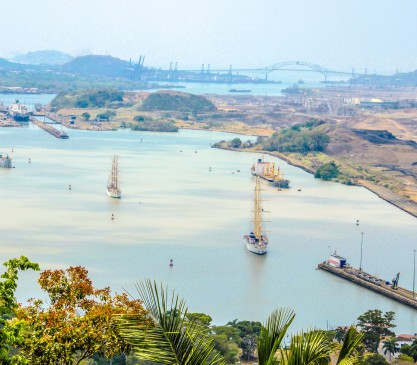
Echoes from the Shore: Culture and Continuity in Coastal Panama
The history of Panama is inseparable from the sea. Before borders and currencies, these coasts were part of vast trade routes: dugout canoes carried cacao, ceramics, and salt along the Pacific; Caribbean bays sheltered merchant ships and corsairs. The Isthmus didn’t divide — it connected. This legacy still pulses through Panama coastal towns, where music, food, and tradition speak a language shaped by salt and time.
On the Caribbean side, in places like Portobelo and Colón, colonial stone forts watch over bays once filled with Spanish treasure fleets. But today, the sound is not cannons — it’s congas and call-and-response chants during the Festival of the Black Christ. This mix of Catholic devotion and Afro-Caribbean ritual is uniquely Panama culture, alive and unfiltered.
Crafts here are rooted in place. Guna Yala women sew molas — vibrant panels layered in fabric — which reflect both ancestral myth and modern identity. Along the Pacific, fishermen build boats by hand, shaping hulls from cedar and memory. These are not souvenirs, but forms of survival and pride.
Then there’s the food. On the coasts, Panama cuisine follows the tides: fried snapper with coconut rice in Bocas, tamales steamed in banana leaves on the Azuero Peninsula. Spices from Africa, techniques from Spain, ingredients from the sea — each dish carries history, yet feels fully local.
There’s a quiet lesson in these rituals: Panama life doesn’t preserve the past in museums — it lives it. Festivals, songs, even recipes change slightly with every generation, but always stay rooted in the sea.
What cultural influences shape Panama's identity? A layered blend of indigenous roots, Afro-Caribbean heritage, Spanish legacy, and maritime exchange — all flowing along the coastlines where history still breathes.
Sailing Seasons in Panama: When Wind and Light Align
June is the hottest month in Havana with an average temperature of 27°C (81°F) and the coldest is January at 21°C (70°F) with the most daily sunshine hours at 11 in July. The wettest month is June with an average of 80mm of rain. The best month to swim in the sea is in August when the average sea temperature is 30°C (86°F).
Check all Statistics in Accuweather
